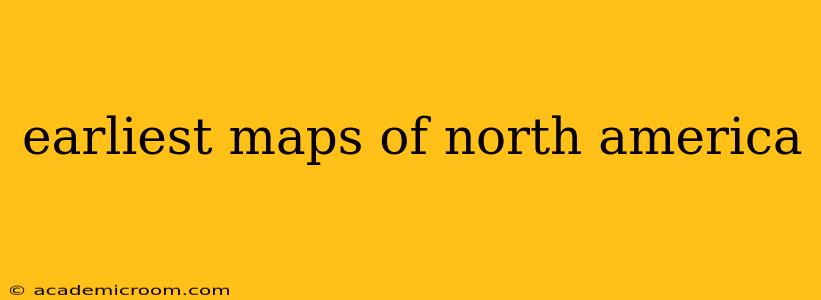The creation of the earliest maps of North America is a fascinating journey through time, reflecting not only the geographical knowledge of the era but also the political, economic, and cultural forces at play. These maps, often imperfect and incomplete, offer invaluable glimpses into the evolving understanding of this vast and diverse continent. From rudimentary sketches to increasingly detailed cartography, the story of North American mapmaking is a testament to human curiosity and the persistent drive to explore and understand the world.
What were the earliest maps of North America like?
The earliest maps of North America weren't the precise, detailed representations we see today. Instead, they were often based on limited information, relying heavily on eyewitness accounts, hearsay, and speculation. Many depicted the continent as a landmass of uncertain size and shape, with coastlines vaguely defined and internal features largely unknown. These early cartographers often incorporated mythical elements, influenced by prevailing beliefs and legends. For example, many early maps included fantastical creatures and exaggerated geographical features.
Who created the earliest maps of North America?
Creating the earliest maps of North America was a collaborative effort involving various groups:
-
Native American Peoples: Indigenous populations possessed extensive knowledge of their local territories, passed down through generations of oral traditions and practical experience. While they didn't create maps in the Western cartographic sense, their intricate understanding of geography significantly influenced the maps created by European explorers and cartographers later.
-
European Explorers: Early explorers like John Cabot, Jacques Cartier, and Giovanni da Verrazzano played crucial roles. Their voyages yielded firsthand accounts and sketches that contributed to a growing, albeit incomplete, picture of the continent's coastlines.
-
Cartographers: These skilled mapmakers compiled the information gathered by explorers, often incorporating data from other sources (some reliable, some not) to create increasingly sophisticated maps. They had to reconcile conflicting accounts and extrapolate from limited data, resulting in maps that often contained errors and inconsistencies.
How accurate were the earliest maps of North America?
The accuracy of early North American maps varied greatly. Coastal regions explored by European navigators were generally depicted with more accuracy than the vast, largely unexplored interior. Many maps contained significant inaccuracies due to limitations in surveying techniques, navigational tools, and the incomplete understanding of the continent's geography. For example, the size and shape of various landmasses were often misrepresented, and features such as rivers and mountains were placed with limited precision. Many errors stemmed from reliance on hearsay and the incorporation of mythological elements.
What are some examples of early North American maps?
Several notable early maps offer a window into the evolving understanding of North America:
-
The Cantino Planisphere (1502): This early portolan chart, a type of navigational map, provides a relatively detailed depiction of the eastern coast of North America. Its accuracy, especially in portraying coastal features, suggests its creation was influenced by firsthand knowledge from recent voyages.
-
The Waldseemüller map (1507): This is historically significant as the first map to use the name "America," honoring Amerigo Vespucci. Although not completely accurate in its depiction of North America, its significance lies in its naming convention which became widely adopted.
-
Maps by various explorers: Maps created by individual explorers, though often limited in scope, provide invaluable insights into specific regions and voyages. Examining these provides direct access to their findings and interpretations of the territories they explored.
How did mapmaking technology improve the accuracy of North American maps over time?
Improvements in navigation and surveying technologies played a crucial role in increasing the accuracy of North American maps. Advances in cartographic techniques, the development of better navigational instruments (like the sextant and chronometer), and improved surveying methods gradually led to more precise and detailed representations of the continent. The use of triangulation and astronomical observations further contributed to the creation of more reliable maps.
The earliest maps of North America represent a fascinating blend of exploration, speculation, and evolving cartographic techniques. They reflect the gradual unveiling of a vast continent, a journey driven by human curiosity and a desire to understand and chart the world. While often imperfect, these maps remain valuable historical artifacts that shed light on the early stages of North American exploration and mapmaking.
